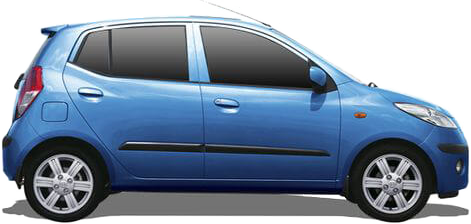The Comparative Analysis :
Hyundai i10 1.1 LPG Automatic (Autogas) (09 - 10) vs. Hyundai i10 1.0 Automatic (20 - ..)
€ 13,800

€ 15,700

€ 13,800
Base Price ⓘBase price of a new vehicle with standard equipment in Germany at market launch.
€ 15,700
ⓘBase price of a new vehicle with standard equipment in Germany at market launch. Price Info
Vehicle Dimensions
The dimensions of these vehicles differ considerably. The i10 1.1 LPG is 10.5 cm shorter, 8.5 cm narrower and 6 cm taller than the i10 1.0.
i10 1.1 LPG
i10 1.0
1540
1595
1870
1480
1680
1961
1595 mm
Width
1680 mm
1870 mm
Width Incl. Mirrors
1961 mm
1540 mm
Height
1480 mm
2380
3565
2425
3670
3565 mm
Length
3670 mm
2380 mm
Wheelbase
2425 mm
Vehicle Weight
i10 1.1 LPG
i10 1.0
1030 kg
Kerb Weight
999 kg
1430 kg
Gross Vehicle
Weight
Weight
1410 kg

Weight Difference:
31 kg
3.01 %

General
i10 1.1 LPG
i10 1.0
PA
Generation
AC3
Hatchback
Car Body Style
Hatchback
Autogas (LPG)
Fuel Type
Unleaded (95 RON)

Front-wheel drive
Drive
Front-wheel drive

4-speed automatic transmission
Transmission
5-speed automated manual transmission (AMT)
Engine
i10 1.1 LPG
i10 1.0
Straight-four engine (naturally aspirated engine)
Engine Type
Straight-three petrol engine (naturally aspirated engine)
3
Valves
4
4
Cylinders
3
1086 CC
Engine Capacity
998 CC
63 bhp
at 5500 rpm
Power
66 bhp
at 5500 rpm
i10 1.1 LPG
63 bhp
66 bhp
i10 1.0
98 NM
at 2800 rpm
Max. Torque
96 NM
at 3750 rpm
i10 1.1 LPG
98 NM
96 NM
i10 1.0
Performance
i10 1.1 LPG
i10 1.0
85 mph
Maximum Speed
97 mph
18.5 sec
Acceleration 0 to 62 mph
17.3 sec
62 mph
62
mph
mph
257 m
0.000 sec

i10 1.1 LPG
62 mph
62
mph
mph
240 m
0.000 sec

i10 1.0
▶ REPLAY
16.35 kg/bhp
Weight-to-Power Ratio
15.14 kg/bhp
i10 1.1 LPG
16.35 kg/bhp
15.14 kg/bhp
i10 1.0
Fuel Economy / Emissions
i10 1.1 LPG
i10 1.0
Fuel Economy
37 mpg
combined
59 mpg
i10 1.1 LPG
37 mpg
59 mpg
i10 1.0
30 mpg
city
53 mpg
43 mpg
motorway
63 mpg
34 L
Fuel Tank Capacity
36 L
278 mi
Range
466 mi
i10 1.1 LPG
278 mi
466 mi
i10 1.0
Environmental Impact
112 kWh
Total Energy Consumption
per 100 miles ⓘThe total energy consumption per 100 miles is the amount of energy consumed by a vehicle when burning fuel or using electricity per 100 miles (final energy), and the energy required to produce the appropriate amount of fuel or electricity (primary energy).
per 100 miles ⓘThe total energy consumption per 100 miles is the amount of energy consumed by a vehicle when burning fuel or using electricity per 100 miles (final energy), and the energy required to produce the appropriate amount of fuel or electricity (primary energy).
90.9 kWh
i10 1.1 LPG
112 kWh
90.9 kWh
i10 1.0
Euro 4
Emission Standard
Euro 6d-TEMP-EVAP-ISC (WLTP) 36CH, 36CI, 36DG
122 g/km (NEFZ)
CO2 Emissions
134 g/km (WLTP)
Practical Convenience
i10 1.1 LPG
i10 1.0
5
Doors
5
5
No. of Seats
5
400 kg
Maximum Payload
411 kg
225 L
Boot Capacity
252 L





910 L
Boot Capacity (Seats Down)
1050 L





















